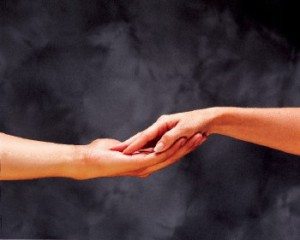Donations into dollars: Peek behind the racks and see how NCJW-LA thrift stores are helping people and the environment.
 By Mary Elizabeth Williams-Villano, LuxEco Editorial Assistant and author of the Resplendent Repurposing series
By Mary Elizabeth Williams-Villano, LuxEco Editorial Assistant and author of the Resplendent Repurposing series
Even wonder what really goes on behind the scenes at your local thrift store? About how your donations are used — are they really helping people? How the charity decides what to charge? What happens to the stuff that doesn’t sell? And just how Green an operation is it, anyhow?
I got an inside peek into the operation of what is perhaps the best-stocked, best-run chain of thrift stores in the greater Los Angeles area when I spoke with executives of the National Council of Jewish Women, Los Angeles at the Fairfax Avenue headquarters.
From them, I learned a great deal about how a modern thrift store operates. I also discovered how important the stores — and your donations — are to NCJW-LA’s central purpose: Helping people. And I also got the inside scoop about those fabulous “Best of Best” sales.
In 2009, NCJW-Los Angeles celebrated its 100th anniversary. “Inspired by Jewish values of helping others – regardless of culture, ethnicity, religion or race,” NCJWs’ chief mission is to “enable women, children and families to build healthy and productive lives, and to thrive.” Programs fall under two headings, Women Helping Women and Women Helping Children.
Services include a talkline, counseling, support groups, the family court project, scholarships, tutoring, after-school, library and art programs, clothing and book giveaways. NCJW-LA is very active in the area of domestic violence and advocacy for women. For a more complete description of all the different ways they are helping people, see National Council of Jewish Women-Los Angeles’s website.
From our talks, it would seem that NCJW-LA’s thrift stores operate in a very eco-friendly manner. And we should also consider the fact that anything sold in a thrift store and therefore not dumped in a landfill is a big, wet kiss for our Earth. See what you think.
I recently interviewed Robert “Bob” Klausner, Director of Retail Operations for NCJW-LA. He revealed how thrift store donations help people in Los Angeles.
Mary Elizabeth Williams-Villano: Mr. Klausner, what is your background?
RK: I’ve been in retailing for about 40 years. I was co-owner of the Clothestime store chain which we sold in 2003 to a private investor. I also worked for TJ Maxx and Lerner New York. I decided to go into the non-profit sector to do something good for the world. I’ve been at NCJW-LA for six years, and I absolutely love what I’m doing, making things happen in the stores for women and children – men, too.
ME W-V: How much of NCJW-LA’s services — its ability to help people — is funded by the thrift stores?
RK: The thrift stores are our main source of revenue. Seventy-five percent of our programs are funded by the stores, the rest by monetary donations.
ME W-V: How has this recent economic downturn affected donations to the thrift stores?
RK: It definitely was noticeable. We weren’t getting the same quality of donations. At the same time, we got more customers. As for donations, things have definitely picked up in the last six months. People have been extremely generous.
ME W-V: What qualities do you look for in new hires for the thrift stores?
RK: Preferably someone with retail experience who wants to move up into management. I would want that person to be interested in giving good customer service. Somebody who wants to help the world. I ask myself how that person would impact the charity – that’s the key.
ME W-V: Many people seem to think that thrift stores wash or dry-clean donated clothing before they put it out for sale. Is that true?
RK: No. The cost of that would be prohibitive, and would wipe out our profits. But nothing that is dirty, stained or torn is ever put out for sale in a Council Thrift store.
ME W-V: What percentage of donations are actually saleable?
RK: Up to seventy-five percent of what’s received from our donors is put out for sale in our stores.
ME W-V: Do your pickup drivers have discretion as to what donations they will accept?
RK: Absolutely. They have the right of refusal, especially when it comes to furniture. We don’t expect them to go through a bag of clothes, but we’re not a dumping ground for people’s garbage. For instance, if we get donations of electronic goods that don’t work, we have to transport them to an e-waste collection site. That costs us money. That’s why we no longer accept televisions over eight years old or computers over five.
ME W-V: You’ve just touched on what’s of primary importance to LuxEco Living readers, and that’s the fact that everything we do impacts our Earth in some way. You’ve mentioned e-waste — what happens to the other donations that NCJW LA’s thrift stores can’t sell?
RK: Those items that we can’t sell get sent to an organization that sells them overseas. Unusable clothing is sold on a per-pound basis to be made into industrial wiping rags, rag rugs and so forth. We do sell some e-waste to a third party — computers, printers, old TVs and so forth. But people should know that all of the money that’s received for such items is used for the charity.
Sometimes we pick up items from our donors that just cannot be sold. These donations would usually be discarded, although we do have some customers that will buy broken pieces.
ME W-V: Let’s say I drop off a donation at the Van Nuys Council Thrift store. Will those items remain at that store?
RK: Not necessarily. Donated items are often transported to other stores, especially for the “Best of the Best” sales.
ME W-V: Speaking of that, the Council Thrift stores’ “Best of the Best” sales have become one of my favorite weekend things to do in this town. When did those sales start, and why?
RK: I came up with the concept about four years ago. I thought it would be a great way to increase the public’s knowledge about our stores.
ME W-V: It seems to be doing that. Every time I attend one of these sales, there are more people shopping than last time. People line up in front of the stores before they open.
RK: Yes, they’re definitely growing.
ME W-V: How are items selected for “Best of the Best? Do you have people with special expertise that pick them out?
RK: Yes – we have former appraisers, people who know about art, collectibles and designer clothing.
ME W-V: How do you decide how to price donation items for “Best of the Best?”
RK: The general rule of thumb is ten to twenty percent of the original retail value, for “Best of the Best” or any of our other merchandise. But there will always be exceptions to this rule.
ME W-V: What happens to the donations that don’t sell after a “Best of the Best” event is over? Are they stashed away until the next one?
RK: After the sale, donations stay in the store until they are sold. The prices are lowered continuously until no longer viable.
ME W-V: Do you ever get entire estates bequeathed to NCJW-LA?
RK: The amount differs every year, but yes, we do get donations of entire estates.
ME W-V: From my own observations, seems like NCJW thrift stores get higher-end donations than some other charity retailers.
RK: I think it’s that we have higher-end know-how. The look of our stores is better. Our customer service is better. We’re known for neat, clean, orderly stores and excellent customer service.
I then spoke with NCJW-Los Angeles’ Executive Director Hillary Selvin.
ME W-V: What is your background, Ms. Selvin?
HS: I have an MBA in nonprofit management. I was also CEO of the West Hollywood Chamber of Commerce.
ME W-V: What would you like the public to know about NCJW-LA?
HS: For over 100 years we have been a vital part of the social service structure of Los Angeles, filling in gaps with all these amazing services not provided by government or other entities. We have social workers on staff, and provide long-term counseling at little or no cost. We partner with other agencies such as the Jewish Vocational Service and P.A.T.H. (People Assisting the Homeless). They give our clients vouchers, and we give their clients vouchers for suits of clothing. We help over 15,000 individuals every year.
ME W-V: With the current economy, have you noticed an uptick in people needing help? Had there been an increased demand for NCJW LA’s services?
HS: There definitely has been a change. There are more people in need of our services than ever before.














